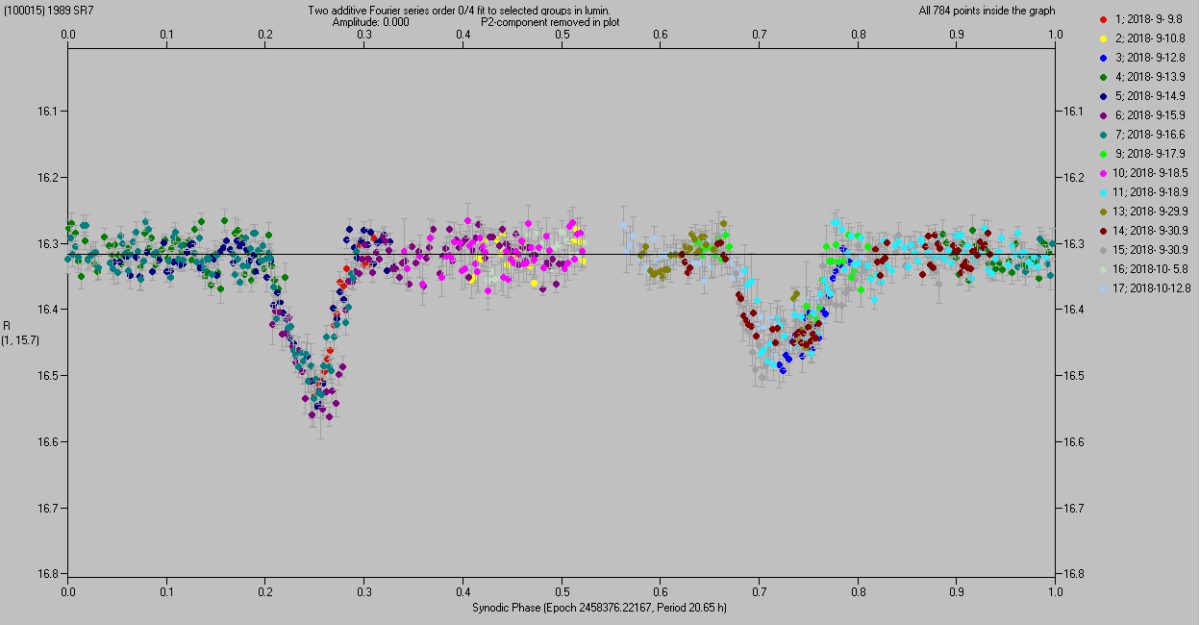Jason Davis • Apr 25, 2019
How Your Donations are Helping Planetary Society Asteroid Hunters
As a Planetary Society supporter, you are quite literally helping to save the world. The asteroid hunters you support through our Shoemaker Near-Earth Object grant program find, track and characterize near-Earth objects, a job too big for the world's professional sky surveys to handle alone.
Thanks to your donations, we awarded $59,300 to 7 asteroid hunters in 2018. The money helped them activate new telescopes, install sophisticated new cameras, and train more asteroid hunters, reducing the chances that humanity gets caught off-guard by an asteroid on track to impact the Earth.
Each year, we ask our Shoemaker winners to help us tell the world about their work. Here's what last year's winners have been up to.
Gene Shoemaker Near-Earth Object Grants
The Planetary Society's Shoemaker NEO grant program funds advanced amateur astronomers to find, track, and characterize potentially hazardous near-Earth objects.
Vladimir Benishek
Sopot Astronomical Observatory
Belgrade, Serbia
Award: $5,060
Benishek used his Shoemaker funds to activate a second telescope at Sopot Observatory. From August to December 2018, he contributed to the discovery of 8 new binary asteroid systems that have been published in the Central Bureau for Astronomical Telegrams of the International Astronomical Union, a community clearinghouse for notable astronomical observations.
Benishek notes that some of those discoveries were made with fellow Shoemaker grant winners Donald Pray, Brian Warner, and Julian Oey, under a program called the Photometric Survey for Asynchronous Binary Asteroids.
Here is a light curve for one of those 8 newly discovered binary asteroids: (100015) 1989 SR7. Looking at the light curve, we can actually see 2 asteroids crossing in front of each other. The left dip was caused by the smaller asteroid transiting in front of and casting a shadow onto the larger one, and the right dip was caused by the smaller body moving behind the larger one.

Daniel Coley
Center for Solar System Studies (CS3)
California, U.S.A.
Award: $8,995
Coley and his colleagues at CS3 purchased a new CCD camera to use with a newly acquired 0.7-meter telescope. They report the camera will be configured and installed soon.
CS3 has received several Shoemaker grants over the years. They have 9 telescopes, and in 2018 determined the rotation period of 289 objects, 161 of which were near-Earth asteroids, and 12 of which were binary asteroids.
Robert Holmes
Astronomical Research Institute (ARI)
Illinois, U.S.A.
Award: $5,500
Holmes used his Shoemaker grant to purchased and activate a new CCD camera for ARI's 0.61-meter telescope. The observatory continues to specialize in observing very faint NEOs. In 2018, ARI made the sixth-most NEO measurements in the world, topped only by big-name observatories like Pan-STARRS and Spacewatch. They also led the pack in observations of extremely dim 22nd magnitude observations.

Gary Hug
Farpoint Observatory
Kansas, U.S.A.
Award: $6,860
Gary Hug reports his 2018 grant enabled him to install a remote control system for the 0.7 meter Tombaugh Reflector at Farpoint Observatory in Kansas, USA.
His group, the Northeast Kansas Amateur Astronomer's League (NEKAAL), is working to bring more NEO observers into the fold by training more members to remotely operate the telescope. One of their recent training sessions at a local high school was recently covered by the Topeka Capital-Journal.
Julian Oey
Blue Mountain Observatory
New South Wales, Australia
Award: $11,845
Julian purchased a new 0.5-meter telescope to go with an existing mount, camera and facility he had at Blue Mountain Observatory. After some challenges with the new telescope mirror, manufacturer Hubble Optics reports it is almost finished and ready for delivery.
In the meantime, Oey made observations that helped confirm two equal-mass binary asteroids: (190166) 2005 UP156 and 2017 YE5. You can read more about Oey's work and the equal-mass binaries in this paper.
Michel Ory
Morocco Oukaïmeden Sky Survey (MOSS)
High Atlas Mountains of Morocco
Award: $9,999
We featured new Shoemaker winner Ory in two stories last year: the equal-mass binary nature of asteroid 2017 YE5, and a deep-dive on MOSS. Ory purchased and installed a new CCD camera using his grant funds, and like other observers continues to send data to the IAU Minor Planet Center. Ory also pointed us to a new book he published, called Chasseur d'astéroïdes.
Donald Pray
Sugarloaf Observatory
Massachusetts, U.S.A.
Award: $11,000
Pray used his grant to purchase a new mount for a 0.5-meter telescope at Sugarloaf Observatory. As a bonus, he sold the old mount and used the funds to purchase a new CCD camera from OPT. Pray said the company gave him a substantial discount because the camera was related to a Planetary Society grant!
With his new equipment, Pray continued his work as a top binary asteroid hunter, contributing data that generated two Central Bureau for Astronomical Telegrams, with more to likely come.

Luca Buzzi
G. V. Schiaparelli observatory
Varese, Italy
Award (2015): $9,995
Buzzi, a 2015 Shoemaker NEO Grant winner, wrote in to tell us that the CCD camera our donors helped purchase a few years ago is still working very well on his 0.84-meter telescope. Starting this year, he has been able to operate the telescope remotely, and in the first 3 months of 2019 Buzzi made 1,300 astrometric measurements of 271 near-Earth objects and 183 main-belt asteroids.
He also sent us pictures from 30 March 2019 of asteroid (06478) Gault, which is slowly breaking apart! Check out the comet-like tail seen in these images.

If that image looks familiar, you may have seen the same asteroid in a recent picture by the Hubble Space Telescope:

Support our core enterprises
Your support powers our mission to explore worlds, find life, and defend Earth. You make all the difference when you make a gift. Give today!
Donate

 Explore Worlds
Explore Worlds Find Life
Find Life Defend Earth
Defend Earth



